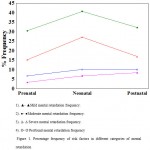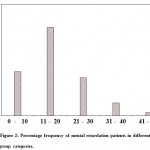How to Cite | Publication History | PlumX Article Matrix
Minakshi Vashist1*, Amit Kumar1, Neelkamal1 and Joginder Kairo2
1Department of Genetics, M.D.University. Rohtak, India.
2Clinical Psychologist, Post Graduate Institute of Medical Science (PGIMS). Rohtak, India.
Corresponding Author E-mail:mvashist@rediffmail.com
ABSTRACT: Mental retardation is among the few major disorders that are still poorly understood in terms of etiopathogenesis and for which very little therapeutic help is provided. Mental retardation may be caused by either genetic or environmental factors or a combination of both. Fifty nine patients of idiopathic mental disability were studied from Pt.B.D.Sharma University of Health Sciences Rohtak, Haryana. There were 13.5% mild, 49.2% moderate, 27.1% severe & 10.2% profound cases of mental retardation. Out of these there were 72.88% males & 27.11% females. All of these patients were with low socio-economic status and illiterate background. Age group range of 11-20 years has highest frequency (47.457%) of mental disability in all categories. In mild group prenatal, postnatal & neonatal risk factors were found in two, five & four respectively. Among moderate group 18 patients were with prenatal risk factors, 19 with postnatal, 24 with neonatal & 2 patients were without any risk factors. In severe group 9 patients have prenatal, 16 patients have postnatal & 16 patients have neonatal risk factors. In profound group prenatal, postnatal & neonatal risk factors were noted in four, six & six patients respectively.
KEYWORDS: Risk Factors; Prenatal; Postnatal; Neonatal, IQ; Mental Retardation
Download this article as:| Copy the following to cite this article: Vashist M, Kumar A, Neelkamal, Kairo J. Evaluation of Prenatal, Postnatal and Neonatal Causes as the Risk Factors for Patients with Different (IQ) Levels of Mental Retardation. Biosci Biotech Res Asia 2011;8(1) |
| Copy the following to cite this URL: Vashist M, Kumar A, Neelkamal, Kairo J. Evaluation of Prenatal, Postnatal and Neonatal Causes as the Risk Factors for Patients with Different (IQ) Levels of Mental Retardation. Biosci Biotech Res Asia 2011;8(1). Available from: https://www.biotech-asia.org/?p=9366 |
Introduction
Mental retardation (MR) is a common disorder, which imposes a large medical, psychological and social burden. It affects about 3% of the population, yet the pathogenesis is poorly understood (Birch et al., 19701 and Curry et al., 19972). Mental disability is described as below average general intellectual function with associated deficits in adaptive behavior that occur before age of 18 (Van et al., 20053). ICD-10 characterizes mental retardation as condition resulting from failure of mind to develop completely. The degree of impairment of mental retardation has a wide range, it is generally divided into mild (IQ 50-70), moderate (IQ 35-50) and severe (IQ 20-35). Those cases in which the IQ is below 20 are occasionally defined as profound (Battaglia et al., 19994 and Chiurazzi 20005). Epidemiology of mental retardation showed that 2 to 3% of population has an IQ less than 70. Severe mental retardation has a prevalence of 3.5 per 1000 individual. The prevalence of moderate to severe retardation (IQ<50) is 30 to 55 per 10,000 and mild handicap (IQ 50-70) is present in about 2% of the population (Roeleveld et al., 19976). These categories of mental abnormality are based on scores obtained through use of age standardized tests of cognitive ability (WHO, 1993)7. There are several hundred disorders associated with mental retardation. Many of these disorders play a causative role in mental dysfunction. The American association on mental retardation subdivides the disorders that may be associated with mental retardation into three general areas, prenatal causes, neonatal causes and postnatal causes (AAMR, 1992)8. Present study has been conducted on patients of mental disability to assess the role of these risk factors
Material and Method
A specialized questionnaire was developed to record the prenatal, postnatal & neonatal history of the mentally abnormal patients. A sum total of 59 patients were analyzed from Pt. B.D.Sharma University of Health Sciences in the year 2009. These patients were divided into the four different categories on the basis of degree of mental retardation. The IQ of these patients was calculated by using the Senguin’s form board test with the help of clinical psychologist. Different risk factors studied are given in Table 2.
Results and Discussion
Out of 59 patients there were 43 males (72.88%) & 16 females (27.11%) (Table1). In the mild category there were 2 prenatal, 5 postnatal, & 4 neonatal cases of risk factors. In moderate group there were 18 prenatal, 19 postnatal, 24 neonatal cases whereas 2 cases do not have any risk factors. In severe group 9 prenatal, 16 natal & 10 postnatal risk factors cases were present. In profound category 4 prenatal, 6 postnatal & 6 neonatal risk factors cases were observed (Fig 1). In age group of 0-10 Yrs there were 23.73% cases of mental disability. In 11-20 yrs age group 47.46% cases were present. In 21-30 Yrs of age group percentage of mentally challenged persons was 20.35%. In age group 31-40 yrs & 41-50 yrs there were 6.78% & 1.7% patients respectively (Fig. 2).
 |
Figure 1: Percentage frequency of risk factors in different categories of mental retardation.
|
 |
Figure 2: Percentage frequency of mental retardation patients in different age group categories.
|
Table 1: Sex distribution in various categories of mental retardation.
| Group of MR | % Frequency of male patients | % Frequency of female patients |
| Profound | 5.08 | 5.08 |
| Severe | 20.34 | 6.78 |
| Moderate | 35.59 | 13.56 |
| Mild | 11.86 | 1.69 |
Table 2: Various Risk Factors Taken Under Consideration in Present Study.
| Prenatal | Neonatal | Post natal |
| Wanted /unwanted Attempted abortion Threatened abortion Rh incompatibility
Diabetes Nutrition Trauma Hypertension Jaundice Infections |
Prolonged Labour duration
Respiratory distress Abnormal presentation Birth weight Delay cry Colour of the baby Respiratory distress Infections Feeding problems Convulsions |
Infections
Jaundice Convulsions Injury Failure to thrive Nutritional disorders |
Table 3.Distribution of various risk factors in Different categories of Mental Retardation
| Risk Factors | Different Levels Of Mental Retardation | Total
(%) |
|||
| Mild | Moderate | Severe | Profound | ||
| Prenatal | 2 | 18 | 9 | 4 | 55.93 |
| Postnatal | 5 | 19 | 10 | 6 | 67.79 |
| Neonatal | 4 | 24 | 16 | 6 | 84.74 |
| Prenatal+ Neonatal
+Postnatal |
1 | 5 | 6 | 2 | 23.72 |
Role of prenatal, neonatal and postnatal time period in identifying the risk factors for mental retardation has been emphasized only in few studies. However, number of articles reports prenatal screening as well as developmental follow up of neonates. In a Japanese study 15% prenatal, 8% perinatal and 12% postnatal causes were reported. Reason of mental disability was uncertain in 65%. Study from Finland reported prenatal risk factors in 22%, perinatal in 1% and postnatal in 3% cases of mental disability. Uncertain reason was reported in 74% cases (Akiko, 2002).
In the present study, prenatal, neonatal and postnatal clinical history of patients was analyzed in detail. Contributory prenatal risk factors were 55.93%, neo-natal 84.74% and postnatal 67.80%. Causes were uncertain in 3.40% of mental retardation cases.
Acknowledgement
The authors are grateful to all the individuals for their co-operation in giving clinical history. ICMR is acknowledged for providing SRF to the research scholar & major research project grant wide letter no.5/4-4/13/M/2006-NCD-1.
References
- Birch, H.G., Richerdson, S.A., Baird, D., Horobin, G. and Ilslay, R. 1970. Mental subnormality in the community a clinical and epidemiological study. Baltimore: Willams and Wilkins.
- Curry, C.J., Stevenson, R.E. and Aughton, D. Evaluation of Mental retardation: recommendations of a consensus conference. Am. J. Med. Genet. 72: 468-477 (1997).
- Van, K.C.D., Jansweijer, M.C., Leenders, A.G., Offringa, M. and Hennekam, R.C. Diagnostic investigations in individuals with mental retardation: systematic literature review of their usefulness. Eur.J.Hum.Genet., 13: 6-25 (2005).
- Battaglia, A., Bianchini, E. and Carey, J.C. Diagnostic yield of the comprehensive assessment of developmental delay/mental retardation in an institute of child neuropsychiatry. Am.J.Med.Genet., 82:60-66 (1999).
- Chiurazzi, P. and Oostra, B.A. Genetics of Mental retardation. Curr.opin. Pediatr., 12:529-535 (2000).
- Roeleveld, N., Zielhuis, G.A. and Gabreels, F. The prevalence of mental retardation: a critical review of recent literature. Dev. Med. Child Neuro.l, 39: 125-32 (1997).
- World Health Organization. 1993. International classification of diseases: 10th revision. Ann Arbor, MI: Commission on Professional and Hospital Activities.
- American Association on Mental Retardation. 1992. Mental retardation: Definition, classification, and systems of supports. Washington, D. C.: American Association on Mental Retardation.
- Akiko, Y., Tomoko, K., Takeshi, M., Keiko, E. and Yoshiteru, Y. An Epidemiological Study on the Cause of Mental Retardation in Yokohama City. Journal of disability and medico-pedagogy, 5:1-10 (2002).

This work is licensed under a Creative Commons Attribution 4.0 International License.





